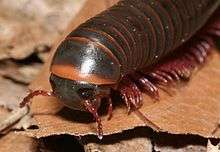Narceus americanus
Narceus americanus is a large millipede of eastern North America. Common names include American giant millipede,[1] worm millipede, and iron worm.[2] It inhabits the eastern seaboard of North America west to Georgetown, Texas, north of the Ottine wetlands.[3] It has a nearly cylindrical gray body, reaching a length of 4 inches (100 mm).[4] When threatened, they sometimes curl up or release a noxious liquid that contains large amounts of benzoquinones which can cause dermatological burns. This fluid may irritate eyes or skin. Many other millipedes secrete hydrogen cyanide, and while there have also been claims that N. americanus releases hydrogen cyanide, this is not true. They do however, excrete a substance that causes a temporary, non-harmful discoloration of the skin.[5]
| Narceus americanus | |
|---|---|
| Scientific classification | |
| Kingdom: | |
| Phylum: | |
| Subphylum: | |
| Class: | |
| Order: | |
| Family: | |
| Genus: | |
| Species: | N. americanus |
| Binomial name | |
| Narceus americanus (Palisot de Beauvois, 1817) | |
Photos
 On floor, note waves of legs
On floor, note waves of legs Curled in defensive position
Curled in defensive position- Defensive position
 On a finger
On a finger Closeup of the head
Closeup of the head
See also
- Tylobolus, a similar-looking genus in the Western U.S.
References
- Millipedes (Diplopoda), Jeff's Nature Page
- Walker, Matt J; Stockman, Amy K; Marek, Paul E; Bond, Jason E (2009). "Pleistocene glacial refugia across the Appalachian Mountains and coastal plain in the millipede genus Narceus: Evidence from population genetic, phylogeographic, and paleoclimatic data". BMC Evolutionary Biology. 9 (1): 25. doi:10.1186/1471-2148-9-25. PMC 2652443. PMID 19183468.
- Stephen Welton Taber & Scott B. Fleenor (2005). "Crustaceans, millipedes, and centipedes". Invertebrates of Central Texas Wetlands. Texas Tech University Press. pp. 263–272. ISBN 978-0-89672-550-8.
- Jennifer Frick-Ruppert (2010). "Railroad worms and millipedes: predators and prey". Mountain Nature: a Seasonal Natural History of the Southern Appalachians. University of North Carolina Press. pp. 106–108. ISBN 978-0-8078-7116-4.
- J. E. Percy, J. Weatherston (1971). "Studies of physiologically active arthropod secretions. V. Histological studies of the defence mechanism of Narceus annularis (Raf.) (Diplopoda: Spirobolida)". Canadian Journal of Zoology. 49 (2): 278–279. doi:10.1139/z71-040. PMID 4925896.
External links

- "Narceus americanus" at the Encyclopedia of Life
